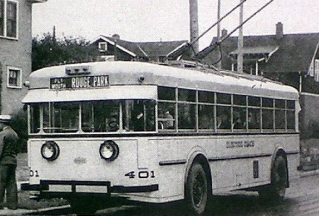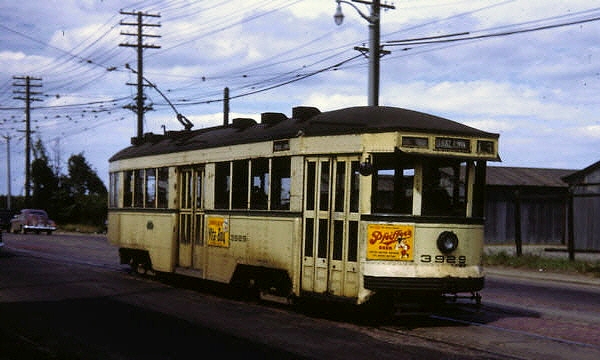| . |
| . |
| . |
| . |
| . |
| . |
| D.S.R. EQUIPMENT PHOTOS — 1930's |
| . |
| FOR D.S.R. 1930's TROLLEY-COACH PHOTOS (PAGE 2) CLICK-ON "NEXT" (Below) |
© 2011 (PAGE LAST MODIFIED ON 08-26-11 (additions 09-06-12, 10-17-13))
| . |
| . |
| . |
| . |
| . |
D.S.R. PETER WITT STREETCARS (ST. LOUIS CAR COMPANY – Lot No. 1540)
| . |
| . |
| . |
At the start of the new decade, the DSR
would launch a less-expensive type of
service than building expensive new rail
lines—"electric buses." Plans were in the
works to expand electric trolley-coach
operation into a network of west-side
electric bus routes that would include the
Livernois, Puritan-Fenkell, Schaefer and
Schoolcraft lines. Unfortunately, the
launching of this new service would come
at one of the worse economic times in
America's history.
would launch a less-expensive type of
service than building expensive new rail
lines—"electric buses." Plans were in the
works to expand electric trolley-coach
operation into a network of west-side
electric bus routes that would include the
Livernois, Puritan-Fenkell, Schaefer and
Schoolcraft lines. Unfortunately, the
launching of this new service would come
at one of the worse economic times in
America's history.
| The transit vehicles displayed in this 1930's Photo Gallery were purchased by the city-owned D.S.R. between 1930 and 1939. Although the DSR would begin the decade with a fleet of 1,776 streetcars (including 269 trailer-cars), that number would drop to 1,108 streetcars by the end of the decade. The 1930s would also usher in the beginning of DSR management's "steel wheels to rubber tires" campaign, with a number of the city's street railway lines being converted to buses by decade's end. |
| Please click-on link to return to the "PHOTO GALLERY" Main Page. |

Plymouth Road Electric Coach #401 (photo courtesy of Tom's Trolley Bus Pix)
| The St. Louis built Witts arrived sporting the DSR's third paint scheme design of cream body with green trim, doors, and striping, first launched in 1927. These cars also arrived sporting the square DSR logo (see insert above), which was similar in appearance to the former square logo used by the DUR. [photo source: Detroit's Street Railways – Vol. II: City Lines 1922-1956 (DSR Files photo)] |
| D.S.R. DEPRESSION-ERA PUBLIC WORKS PROJECTS |
D.S.R. BUILT STREETCAR #401 — THE "BLUE STREAK"
| In 1933, President Franklin D. Roosevelt was able to implement his "New Deal"— a series of economic reform programs started during the Great Depression. Many of these programs were designed to create public sector jobs for the unemployed. One of the New Deal agencies — the Public Works Administration (PWA) — provided the DSR with funds to finance track rebuilding projects, while other New Deal programs allowed the DSR to hire over 1,280 men to work in the DSR shops during the mid-1930s. |

| Even though no new streetcars were purchased by the DSR after that 1930 (130-car) Peter Witt order, a unique-looking streetcar would soon arrive on Detroit streets, but his car would not be purchased by the DSR, it would be built by the DSR. In 1934, an experimental streetcar would be built at the DSR shops in Highland Park and numbered as car #401. The car is pictured here at its permanent home—the Baker Carhouse—which was located on W. Vernor and Livernois. [photo courtesy of the S. Sycko photo collection] |

| Car #401 was built with many advanced features that were slightly ahead of its time, including welded sides, safety glass, indirect interior lighting, and a streamlined exterior. Initially, 35 of these cars were to be built, but DSR management was not fully satisfied and no other cars were produced. The car's four 25-horsepower motors were 5 mph faster than the Peter Witt cars, but because of its size and low ceiling the Blue Streak found itself confined to the lightly-patronized Woodmere line. Car #401 would become the third and last streetcar to be built by the DSR. [photo source: "Dave's Electric Railroads – DSR" — Bill Volkmer collection photo] |

| The Blue Streak would spend its entire service life assigned to the light Woodmere line, where it began service on October 31, 1934. In this photo, car #401 is across from the Baker Carhouse, which it passed on every trip while traveling along Livernois working the Woodmere route. [photo source: "Dave's Electric Railroads – DSR" — Stephen M. Scalzo collection photo] |

| The St. Louis #38-3900-series Peter Witts underwent four color schemes during their service lives. In 1934, with the help of federal CWA funds, the DSR launched its fourth streetcar paint scheme of cream body with only a green belt trim and striping. This livery also ushered in the DSR's new wings logo (above). Car #3929 is seen here southbound along Oakland Avenue just south of Victor in 1950 while working the Oakland line. This second paint scheme used on the St. Louis built fleet would survive the longest, and was still found on some cars as late as 1950. [photo source: Jim Buckley photo collection] |

| By 1946, the DSR had launched its fifth paint scheme of cream body with black striping and black trim. Car #3888 is seen here sporting that livery (the 3rd used on the St. Louis cars) while southbound along Woodrow Wilson just south of Oakman Blvd while working the Trumbull line. Car #3888 was also one of 53 cars from this fleet that were converted to one-man car operation in 1947. By moving the farebox along-side the motorman, the conductor (who collected fares near the center doors) was eliminated, and the one-man cars were reserved for lighter routes. [photo source: online – unknown (unidentified) photo collection] |
| . |
| The St. Louis built Peter Witts arrived sporting the DSR's third paint scheme design of cream body with green doors, trim, and striping, first launched in 1927. These cars also arrived sporting the square DSR logo (see insert above), which was similar in appearance to the former square logo used by the DUR. |

| Between 1933-34, the DSR was also able to use funds from another New Deal agency, the Civil Works Administration (CWA), to overhaul and repaint 500 of its streetcars. In addition to over- hauling over 620 streetcar trucks and motors, and launching a new paint scheme (see photo #2 – car #3929 ), another project included adding a third set of doors to its Peter Witt cars to speed up loading and unloading of passengers. Car #3574 above, photographed some years later, was one of only 38 Peter Witts to receive the rear doors, controlled by a lever next to the conductor. [photo courtesy of the S. Sycko photo collection] |

| . |
| BACK TO THE 1920's |
| THE 1990's 1 2 3 |
| THE 2010's 1 2 |
| THE 2000's 1 2 |


| Although most of the department's Peter Witt streetcars were scrapped after the Baker line was converted over to buses in 1952, twelve cars were retained for back-up and tripper service on the four remaining PCC lines through 1954. The last twelve Peter Witt cars to remain in service were all from this last fleet: 3852, 3853, 3865, 3866, 3874–3877, 3880, 3882, 3886 and 3903. [photo courtesy of the Krambles-Peterson archive collection: RV Mehlenbeck Photo] |
| RV Mehlenbeck Photo, Krambles-Peterson archive (www.DetroitTransitHistory.info) |

| Between 1930 and 1931, a fleet of 130 Peter Witt cars (#3851-3980) were delivered to the DSR, increasing the DSR's Peter Witt style streetcar fleet to 781 cars. These 52-passenger cars, built by the St. Louis Car Company, were 48' 6" long, 8' 6" wide, with four different motor types used to power the fleet. These would be the last new fleet of streetcars purchased by the DSR until 1945. Unlike previous fleets, these Witts came with large single-pane passenger windows. The above photo shows the first car of the fleet—car #3851—being delivered by flatbed railroad car. |
All Walter P. Reuther Library, Wayne State University photos posted with permission.
All rights, including those of further reproduction and/or publication, are reserved in full by the Walter P. Reuther Library, Wayne State University.
Photographic reproductions may be protected by U.S. copyright law (U.S. Title 17). The user is fully responsible for copyright infringement.
All rights, including those of further reproduction and/or publication, are reserved in full by the Walter P. Reuther Library, Wayne State University.
Photographic reproductions may be protected by U.S. copyright law (U.S. Title 17). The user is fully responsible for copyright infringement.
| . |

| The 39-passenger streamlined car was 39' 2" long, 8' 4" wide, and was built from salvaged parts and motors from scrapped DSR Birney Saftey cars purchased back in 1921. Car #401 would be nicknamed the "Blue Streak" because of its silver and blue color paint scheme. [photo source: online – unknown (unidentified) photo collection] |
| . |

| Pictured here is the rear interior view of DSR car #401. Although equipped with leather seats, safety glass and indirect interior lighting, its low ceiling created problems for taller passengers. [Walter P. Reuther Library, Wayne State University photo #28486 — see disclaimer below] |
| Sometime around 1950, the DSR's last remaining Peter Witt cars would undergo their last paint scheme (the 4th for these St. Louis cars) of cream body with red trim and no striping. In this photo, taken on Sept. 2, 1951, car #3922 is south along Oakland Avenue at Massachusetts Street in Highland Park while working the Oakland line en route downtown to Library and Gratiot. [photo source: online – unknown (unidentified) photo collection] |

| It appears that the Blue Streak had been placed out of service by the early 1940s, but during World War-II the car was brought back into service, repainted, and returned to the Woodmere line. This photo shows car #401 during its last years sporting the DSR color scheme of cream with black trim. Car #401 was retired in 1948 after nearly 14 years of service. [photo source: "Dave's Electric Railroads – DSR" — Bill Volkmer collection photo] |